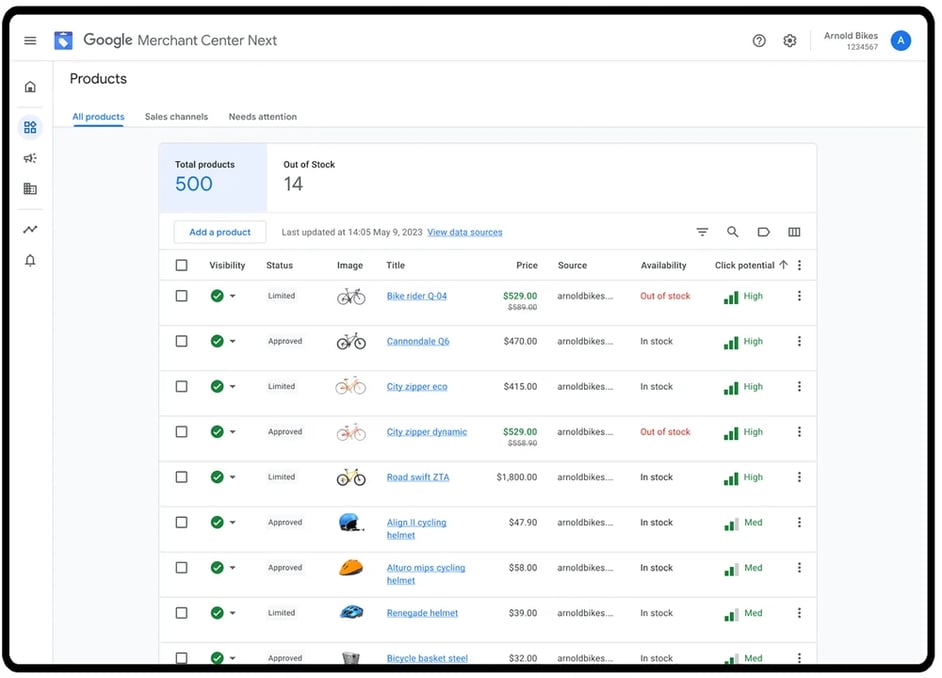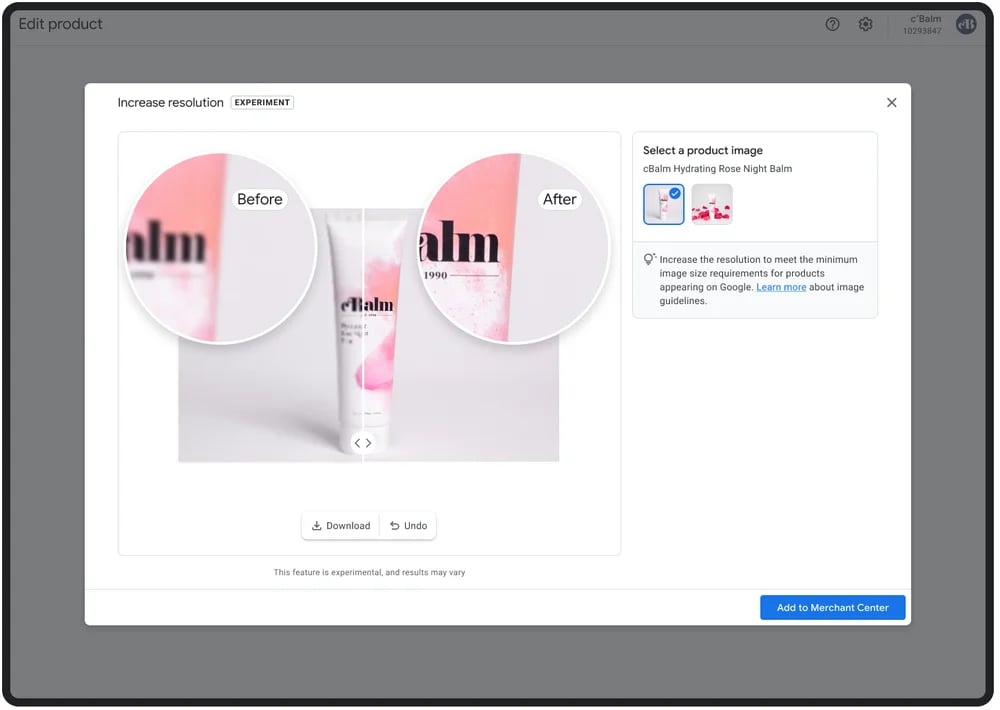Google Merchant Center Next: A Glimpse into the Future of E-commerce
Posted on September 7, 2023 (Last Updated: September 13, 2023)
)%20(1).png?width=1200&length=1200&name=Copy%20of%20Blog%20banner%20%20EMAIL%20MARKETING%20(Presentation%20(169))%20(1).png)
In May 2023, Google made waves in the advertising world with the introduction of their latest offering, Merchant Center Next (GMC Next), at the highly anticipated Google Marketing Live event. This revolutionary update brings a whole new level of sophistication to the advertising experience by harnessing the power of cutting-edge AI tools across Google's suite of platforms, including Google Merchant Center and Google Ads.
The rollout of GMC Next is currently underway for new merchants, with existing ones scheduled to transition in the coming months, aiming for a complete migration by 2024. While merchants have the option to opt in or accept invitations to GMC Next, it's important to note that it doesn't yet provide all the features found in the classic experience known as GMC Classic.
However, the introduction of GMC Next is a significant step forward in simplifying the e-commerce experience, particularly for smaller merchants who may have limited resources. One of the standout features of GMC Next is its automated product feed creation. Google can now crawl websites to automatically detect and import product data, streamlining the process of building initial product feeds. This is especially beneficial for new merchants who may be navigating the advertising landscape for the first time. However, it's worth mentioning that the automatically generated feed may not be fully optimized for Search or Shopping campaigns, as it may not meet Google's listing requirements and best practices.
Additionally, GMC Next offers the convenience of in-platform product data editing. Merchants can now directly edit product details within the interface, including attributes like titles, descriptions, and brand names. This feature provides a level of flexibility that was previously unavailable, making it easier for businesses to make quick updates and adjustments. However, it's important to note that this editing feature is primarily suited for businesses with smaller catalogues, as it operates on a product-by-product basis.
Another exciting addition to GMC Next is the Product Studio, a new visual editing tool that allows for quick enhancement and editing of product images. Leveraging the power of AI, merchants can now remove backgrounds, enlarge images, and even create new scenes, resulting in more visually appealing product listings. This enhancement is sure to catch the attention of potential customers and increase engagement.
Furthermore, GMC Next introduces a "click potential" metric, which estimates a product's performance potential in comparison to top-performing products. This valuable metric provides merchants with insights into the potential success of their products, allowing for more informed decision-making. However, it's important to note that this metric does not directly address poorly optimized listings, so additional optimization efforts may still be required.
In terms of design and layout, GMC Next brings a cleaner and more user-friendly experience to merchants. The updated interface is reminiscent of previous Google Ads interface upgrades, providing a seamless transition for users. However, it's worth mentioning that some features have been relocated or are currently missing, and historical data or product feeds cannot be accessed at this time. This is an aspect that Google may need to address in future updates to ensure a smooth transition for all merchants.
GMC Next also simplifies the process of adding support information within the Merchant Center. Retailers can now easily provide customer service information, including phone numbers, email addresses, web pages, and chat availability. This added convenience allows for enhanced customer support and fosters a positive shopping experience.
While GMC Next introduces a range of exciting new features, it does have its limitations. For instance, the automated feed creation may lack optimization, making it less suitable for businesses with specific requirements. Additionally, in-platform editing may not be scalable for businesses with large catalogues, as it operates on a product-by-product basis. Furthermore, there is currently no efficient way to create optimization rules, and syndication and manual synchronization are limited. These limitations highlight the need for businesses to consider supplementing GMC Next with robust feed management platforms that offer more scalability, optimization, and syndication capabilities.
GMC Next represents a significant step forward in simplifying the e-commerce experience and empowering merchants with cutting-edge AI tools. While it offers exciting new features and a streamlined interface, businesses must carefully assess their needs and consider supplementing them with specialized tools to truly maximize their e-commerce potential. Platforms like WakeupData provide comprehensive feed management solutions that can streamline product listings, optimize feeds, protect data, and more, enabling businesses to excel across all selling channels. With a focus on performance and efficiency, these solutions can help merchants navigate the evolving landscape of online advertising and achieve their business goals.
 Image Source: Google
Image Source: Google
If a merchant activates GMC Next and finds it limiting for their needs, they can easily revert back to GMC Classic. This flexibility allows merchants to choose the platform that best suits their requirements and preferences. However, it's important to note that once a merchant switches back to GMC Classic, they won't be able to switch back to GMC Next until Google initiates another migration.
The vision behind GMC Next is to simplify the e-commerce experience and make it more accessible for all merchants, especially smaller ones. Google recognizes the challenges faced by businesses with limited resources and aims to provide them with a user-friendly platform that streamlines the process of managing product listings and advertising campaigns. By introducing features like automated product feed creation, in-platform product data editing, and the Product Studio tool, GMC Next empowers merchants to enhance their online presence and attract more customers.
By offering the option to revert back to GMC Classic, Google acknowledges that not all merchants may find GMC Next suitable for their specific needs. Some businesses may have unique requirements or prefer the familiarity of GMC Classic. Regardless of the platform chosen, Google's goal remains the same - to provide merchants with the tools and resources they need to succeed in the e-commerce landscape.
Here's a closer look at what's new and what's lacking:
New Features in GMC Next:
- Automated Product Feed Creation: Google can now crawl websites to automatically detect and import product data. This feature is a boon for new merchants as it simplifies the process of building initial product feeds. However, the resulting feed may not be optimized for Search or Shopping campaigns, as it may not meet Google's listing requirements and best practices.
 Image Source: Google
Image Source: Google
- In-Platform Product Data Editing: GMC Next allows direct editing of product details within the interface. This includes attributes like titles, descriptions, brand names, and more. While this feature enhances flexibility, it's primarily suited for businesses with smaller catalogues due to its product-by-product limitation.
- Product Studio: This new visual editing tool enables quick enhancement and editing of product images. It leverages AI to remove backgrounds, enlarge images, and create new scenes, providing greater visual appeal to product listings.
.gif?width=600&height=430&name=ezgif.com-video-to-gif%20(1).gif) Video Source: Google
Video Source: Google
- Click Potential Metric: GMC Next introduces a "click potential" metric, estimating a product's performance potential in comparison to top-performing products. While this metric provides insights, it doesn't directly address poorly optimized listings.
- Design and Layout Changes: The updated design offers a cleaner and more user-friendly experience, akin to previous Google Ads interface upgrades. However, some features have been relocated or are missing, and there's currently no way to access historical data or product feeds.
- Easier Support Information Addition: GMC Next makes it easier for retailers to provide customer service information within the Merchant Center, including phone numbers, email addresses, web pages, and chat availability.

Image Source: Google
Feed Limitations in GMC Next:
Despite these new features, GMC Next has its limitations:
- Automated feed creation may lack optimization.
- In-platform editing is not scalable for businesses with large catalogues.
- No efficient way to create optimization rules.
- Limited syndication and manual synchronization.
- Lack of data governance safeguards.
To overcome these limitations and truly excel in product feed management, businesses may need to consider robust feed management platforms that offer more scalability, optimization, and syndication capabilities.
In conclusion, while GMC Next offers exciting new features and a simplified e-commerce experience, businesses must carefully assess their needs and consider supplementing them with specialized tools to maximize their e-commerce potential.
Businesses should consider supplementing in order to genuinely excel at product feed management.To work around the restrictions of Google Merchant Centre Next, a strong feed management solution such as WakeupData is required.
We provide you with the opportunity to manage your advertising efforts on Google Ads as well as a variety of other paid search, social media, and affiliate platforms. Furthermore, we allow you to compile and share your source data across many marketplaces, allowing you to implement a comprehensive omnichannel approach.
Our comprehensive, fully managed solution is intended to streamline product listings, optimise feeds, protect your data, and more, with the goal of maximising your performance across all of your selling channels.
Let us enable your performance.



